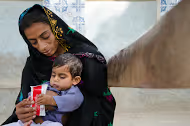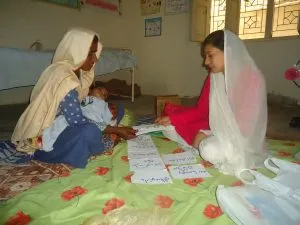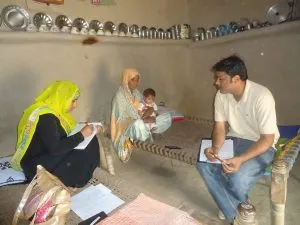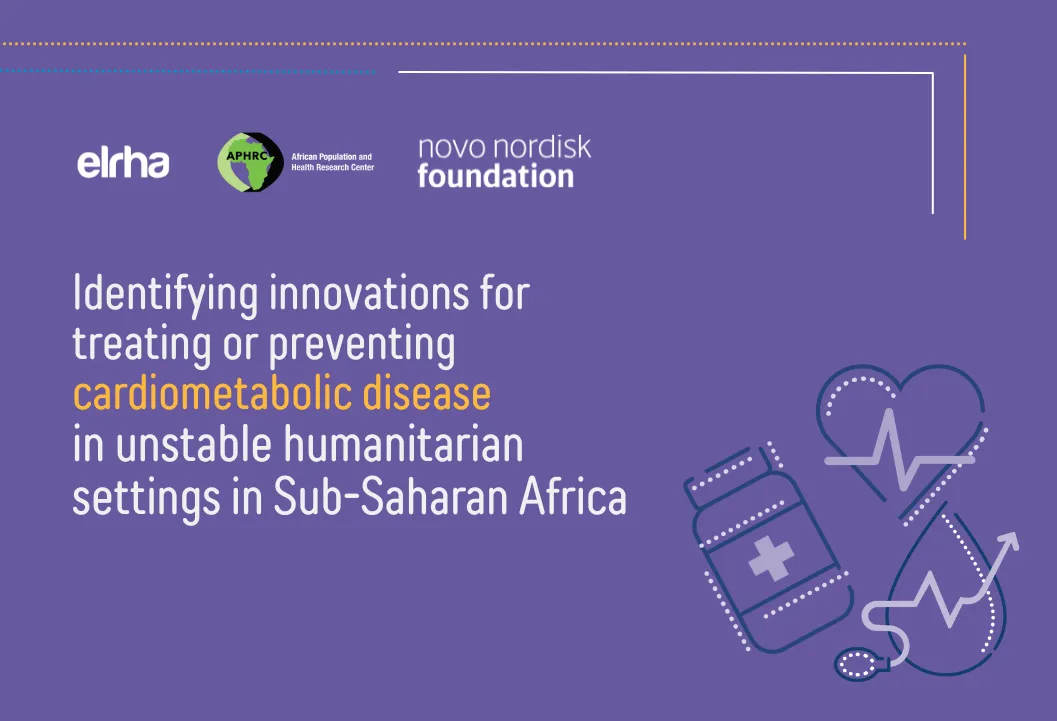Integrating Safe Drinking Water

[caption id=attachment_6370"align="alignleft" width="300"]

Benazir, R2HC Hygiene Promoter, conducts a session on personal hygiene for Abrab,who has brought her son, Ajeeb, 12 months old, for follow-up at the CMAM site[/caption]
This study involvescollecting both quantitative and qualitative data to compare the effectiveness of three different water treatmentmethods in the context of a CMAM program that ACF operates in Dadu District of Sindh Province. We began data collectionin February, and have been working through numerous challenges in the field through the energy of a skilled andmotivated field team.
The process of the study involves enrolling study participants at CMAM sites as they cometo enter their children in the CMAM program. The 20 study sites are split into the four arms of the study, with adifferent water treatment device allocated to each arm. One arm receives ceramic filters, another receives PUR sachets,a third receives Aquatabs, and the final arm serves as a control group. In all four groups, study participants receivehygiene promotion at the time of enrollment. The field team members enrolling the participants also give a fulldemonstration of the water treatment devices, ensuring that participants understand their use and/or maintenance. Whenparticipants return to the CMAM sites for their weekly monitoring visits, our field staff are also there to record thechildren’s progress toward recovery from SAM and to offer additional information on health and hygiene.
Tocomplement this quantitative data, a small subset of participants also provides qualitative data. Some field teammembers visit these participants in their homes to take in-depth interviews, gathering rich information aboutparticipants’ understanding of child health, care-seeking behavior, and use of the water treatment devicesdistributed.
Though both the project and the environment are challenging, the field team has worked together topursue creative solutions. Field staff enrolling participants at CMAM sites face difficulties in shortage of space, timepressure from participants who are coming for new enrollment or for follow-up visits, and a variable security situationthat may cause sites to close on some days.
We have maintained close collaboration with the staff at these CMAMsites, so that the nurses enrolling children in the CMAM program understand the study aims and give vital support to theteam in the field. Another challenge is that in the local context male field staff cannot always access female studyparticipants in order to take surveys or interviews. Our female staff have been a great asset in this regard,particularly when the study requires visiting participants’ homes.
[caption id="attachment_6371"align="alignright" width="300"]

Marvi and Waheed, R2HC Hygiene Promoter – Data Gatherers, carry out an in-depthinterview for qualitative data collection with Ameena & her daughter Aneela, 8 months[/caption]
Enrollment inthe study will be ongoing for another two months on a rolling basis, and we are excited about the continued opportunityto engage with challenges in thefield.[captionid="attachment_6370" align="alignleft" width="300"]

Benazir, R2HC Hygiene Promoter, conducts a session on personal hygiene for Abrab,who has brought her son, Ajeeb, 12 months old, for follow-up at the CMAM site[/caption]
This study involvescollecting both quantitative and qualitative data to compare the effectiveness of three different water treatmentmethods in the context of a CMAM program that ACF operates in Dadu District of Sindh Province. We began data collectionin February, and have been working through numerous challenges in the field through the energy of a skilled andmotivated field team.
The process of the study involves enrolling study participants at CMAM sites as they cometo enter their children in the CMAM program. The 20 study sites are split into the four arms of the study, with adifferent water treatment device allocated to each arm. One arm receives ceramic filters, another receives PUR sachets,a third receives Aquatabs, and the final arm serves as a control group. In all four groups, study participants receivehygiene promotion at the time of enrollment. The field team members enrolling the participants also give a fulldemonstration of the water treatment devices, ensuring that participants understand their use and/or maintenance. Whenparticipants return to the CMAM sites for their weekly monitoring visits, our field staff are also there to record thechildren’s progress toward recovery from SAM and to offer additional information on health and hygiene.
Tocomplement this quantitative data, a small subset of participants also provides qualitative data. Some field teammembers visit these participants in their homes to take in-depth interviews, gathering rich information aboutparticipants’ understanding of child health, care-seeking behavior, and use of the water treatment devicesdistributed.
Though both the project and the environment are challenging, the field team has worked together topursue creative solutions. Field staff enrolling participants at CMAM sites face difficulties in shortage of space, timepressure from participants who are coming for new enrollment or for follow-up visits, and a variable security situationthat may cause sites to close on some days.
We have maintained close collaboration with the staff at these CMAMsites, so that the nurses enrolling children in the CMAM program understand the study aims and give vital support to theteam in the field. Another challenge is that in the local context male field staff cannot always access female studyparticipants in order to take surveys or interviews. Our female staff have been a great asset in this regard,particularly when the study requires visiting participants’ homes.
[caption id="attachment_6371"align="alignright" width="300"]

Marvi and Waheed, R2HC Hygiene Promoter – Data Gatherers, carry out an in-depthinterview for qualitative data collection with Ameena & her daughter Aneela, 8 months[/caption]
Enrollment inthe study will be ongoing for another two months on a rolling basis, and we are excited about the continued opportunityto engage with challenges in the field.
Stay updated
Sign up for our newsletter to receive regular updates on resources, news, and insights like this. Don’t miss out on important information that can help you stay informed and engaged.
Related articles

.png)

Explore Elrha
Learn more about our mission, the organisations we support, and the resources we provide to drive research and innovation in humanitarian response.